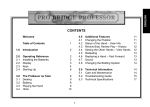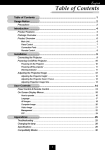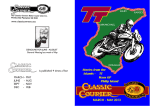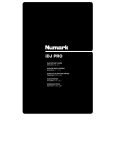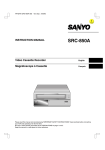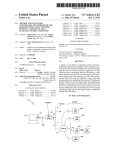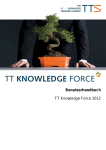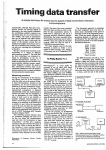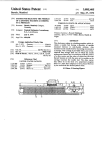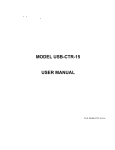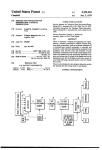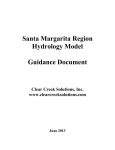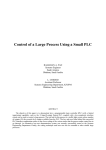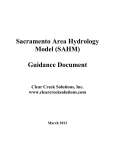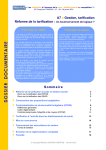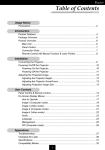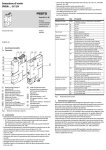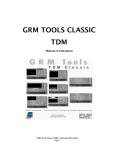Download /l0 E I [l4 {l5 [I7 [I E
Transcript
United States Patent [19]
[11]
4,132,141
Campbell et al.
[45]
Jan. 2, 1979
Model PP-l, Assembly Number ATL-3288, Oct. 20,
[54] SOLENOID-HAMMER CONTROL SYSTEM
FOR THE RE-CREATION OF EXPRESSION
1975.
EFFECTS FROM A RECORDED MUSICAL
PRESENTATION
Assembly Instruction for Teledyne Piano Recorder/
Player Model PP-l, Assembly number ATL-3288, Jul.
10' 1975'
[75] Inventors: Joseph M. Campbell; William S.
Finley, both of Lewisburg, Tenn.
.
.
.
Primary Examiner-Stanley J. Witkowski
[73] Ass‘gnee' 2:236“: g?gsmes’ Inc" Los
Attorney, Agent, or Firm-Jim Zegeer
[21] Appl. NO.: 680,996
[57]
[22] Filed!
APR 28, 1976
ABSTRACT
There is disclosed an expression system for playback of
[51] Int. 01.2 ........................ .. 6106 3/04; GlOH 1/02
[52] us. 01. ....................................... .. 84/115; 84/l.l;
e megnetie tepe reeerd rendition of a musical Presente
?en- The deteeted intensity level for the bass and treble
84/ 1.27; 84/ 1.28; 84/DIG. 29
halves of the keyboard are assigned different data bit
[58] Field of Search .................... .. 84/ 1.02, 1.03, L09,
positions in the frames of recorded data bits of a time
84/ 1.1, 1.24, L27, 1.28, 115, DIG. 29
division multiplexed record system. The binary bits are
[56]
.
References Cited
U-s- PATENT DOCUMENTS
3,871,247
3,905,267
4,023,456
3/1975
9/1975
5/1977
weighted and used to modulate the width of pulses
supplied to selected solenoids which actuate the striker
hammer members of the instrument so that the average
Bonham .......................... .. 84/1.03 x
Vincent ................... .. 84/115
Groeschel ............................ .. 84/115
drive energy applied to the solenoid is Proportional to
the desired intensity thereby more faithfully reproduc
the manual action of the
performen
OTHER PUBLICATIONS
Service Manual for Teledyne Piano Recorder/Player
2 Claims, 6 Drawing Figures
I9&
D
5
/l0
g ll-l
E I
3
IIZ
[l4
_
Q
g
g I
Q
:
;
5
"-N
W
|3
BIPHASE
SPACE/MARK
ENCODER
"-5
GEN] \IO‘S
{l5
l5
[I7
[I
Bl-PHASE
.z :
RECORD / SPME/MARK
[HIGHER
‘a
5g
E
L“
E’ {I
— Q
5 l5
2
'
E
THE RECOVERY
3%
an mop our
SYNC. comm
BIT H FRAME
COUNTER
_
g
U.S. Patent
Jan. 2, 1979
Sheet 1 of 6
4,132,141}
I0
s
a:
8
m
/
l2
3 L
f '4
g
5
g
g
g
5
:2
i
B
f
I '5
BlPHASE
TAPE
SPACE/MARK
ENCODER
RECORD /
PLAY
I5
l '7
fl
BI'PHASE
Ei
SPACE/MARK
DECODER
. Q {I
% f5
‘
23
Q
u-s
H-N?
'
-
~
‘
TIMING
[8
TIME
RECOVERY
an DROP OUT
BIT a FRAME
COUNTER
3
m
g
L“
E ‘I4
E
Q |
Q
.
US. Patent
Jan. 2, 1979
Sheet 2 Of6
4,132,141
BIT ASSIGNMENT
1.
01416
44.
04
87.
D32
2.
3.
D
D#
45.
46.
A
M!
as.
89,
016
4.
s.
6.
7.
8.
E
F
E4
c
G#
47.
48.
49.
50.
51.
B
c
c4
D
D1!
90.
91.
92.
93.
94,
9.
A
52.
E
10.
11.
12.
13.
14.
15.
16.
17.
18.
19.
20.
21.
M
B
c
c#
D
D#
E
F
F#
G
c4
A
53.
54..
55.
56.
57.
58.
59.
60.
61.
62.
65.
64.
1=
F#
c
c1:
A
M
B
c
c#
D
D4
E
96.
97.
98.
99.
100.
101.
102.
103.
104.
105.
106.
107.
22.
23.
24.
25.
26.
27.
28.
29.
30.
31.
32.
33.
34.
as.
36.
37.
38.
A1!
65.
66.
67.
68.
69.
70.
71.
72.
73.
74.
75.
76.
77.
78.
79.
30.
81.
F
E4
c
c#
A
M
B
c
c#
D
D4
E
F
F#
s
G#
A
108.
BASS INTENSITYS
109.
110.
111.
112.
113.
114.
115.
116.
117.
118.
119.
120.
121.
122.
123.
124.
BASS INTENSITY 4
0
TREBLE THEME
TREBLE INTENSITY
TREBLE. INTENSITY
TREBLE INTENSITY
TREBLE INTENSITY
0
SUSTAIN PEDAL
SOFT PEDAL
B
c
c#
D
D11‘
E
F
F4
c
c#
A
A#
B
c (MIDDLE)
c#
D
-
0
9s.
0
0
BASS THEME
BASS INTENSITY 1
BASS INTENSITY 2
1.
1
1
39.
D#
82.
A#
125.
1
40.
41.
42.
E
F
F#
as.
84.
85.
B
c
A32 -
126.
127.
12s.
1
0
1
4s.
0
86.
M32
SYNC
(14 ‘UNASSI'GNED BITS)
1
2
s
4
US. Patent‘ Jan. 2, 1979
523: $285% E
£215
.50b
uQ
a
L155?@mE.
éwlmma
K?
$_:5.0,A;
<
0-“
5%g:
m
Sheet 3 of6
AQUZAM
U.S. Patent
Jan. 2, 1979
Sheet 5 of6
@UZJM
s>
a;9-h
N?
>2
m5
v
..
2
$0
__
w
m
wzoN
¢
Smmww
Q
s.
0
H;
.w
_
In
@L
m
Haga
1
4,132,141
2
The above publications describe in detail a speci?c
and preferred embodiment of an electronic player piano
incorporating the invention defined in the claims hereof
as made and sold by the assignee hereof.
Referring now to FIG. 1, the keyboard of a piano is
SOLENOID-HAMMER CONTROL SYSTEM FOR
THE RIC-CREATION OF EXPRESSION EFFECTS
FROM A RECORDED MUSICAL PRESENTATION
The present invention is directed to electronic player
pianos, and, more particularly, to a novel expression
re-creation system for such instruments.
designated by the numeral 1W as a keyboard data source.
It could be any musical keyboard instrument source
such as a harpsicord, carillon, organ, piano, etc., and
each output or switch actuation is indicated by a single
BACKGROUND OF THE INVENTION
The prior art hammer-solenoid systems disclose that 10 line ll-l through ll-N, the number of such output lines
corresponding to the number of key switch actuations
to‘ control the volume or expression, (how hard the
to be sensed and recorded for example, eighty keys, the
instrument is struck) the voltage at which the solenoids
“sustain” and “sof ” pedals of an eighty-eight key piano
are energized is varied to control the energy transferred
may be sensed. A multiplexer 12 (shown in detail in said
to the instrument to re-create musical notes with the
Service Manual) scans or looks at each individual line
original artist’s expression. In one known case, the ex
11-l..11-N in a timed sequence which constitutes frames.
pense to control the drive to each note would be prohib
Thus, the key switches, sustain and loud pedal, actua
itive for producing units. There also is the question that,
tions are sensed by the digital mutliplexer 12, one at a
if sensing the volume of piano after the key is struck and
time, and in a generally sequential fashion. However, if
then playing back, the correct timing exists to allow the
20 no transpositions are contemplated, it is not necessary
volume to control the, solenoid drive.
that they be sequentially examined; they may be looked
The object of the present invention is to provide a
at or scanned in groups and in any fashion or order, the
more faithful rendition of the recorded expression ef
only ‘criteria being that the position of the particular
fects of a musical presentation.
switch in its scan time be maintained in the entire sys
25 tern.
THE PRESENT INVENTION
The multiplexer thereby translates the parallel data of
In accordance with the present invention, the energy
the key switch actuations to a serial data stream along
supplied to one or more selected hammer-solenoid actu
its output line 13. This data is then encoded to a bi-phase
ators is supplied by a sequence of pulses. The intensity
level (or force with which the performer strikes a key)
space (or mark) signal in bi-phase space (or mark) en
coder 14 and then recorded on magnetic tape in tape
recorder 15. It will be appreciated that magnetic tape
recorder 15 is conventional in all material respects and
is digitized to a binary bit form and recorded on mag
netic tape as a series of binary bits, in a given time frame
or frames of a time-division-multiplexed signal. The
width of the sequence of pulses as supplied to the sole
need not be disclosed or described in any detail herein.
It can be the same as is disclosed in any of the prior art
noids is modulated in accordance with the binary bits of 35 patents referred to earlier herein for recording digital
the digitized signal whereby the average drive intensity
data on tape or, preferably, as shown in the included
supplied to the selected solenoids is a function of the
“Service” and “Installation” Manuals.
As mentioned earlier, there is a slight difference in the
time when a key of a piano, for example, is struck and
when the note reaches the maximum sound intensity so
that if a microphone is used to detect intensity, a delay
width of said pulses.
BRIEF DESCRIPTION OF THE DRAWINGS
The above and other objects, advantages, and fea
tures of the invention will become more apparent in
(not shown) may be introduced prior to the encoding of
the keyboard binary bits at positions 1-88 of bit assign
light of the following speci?cation and accompanying
drawings wherein:
ment chart of FIG. 2 (all 88 keys of a piano have as
FIG. 1 is a block diagram of an electronic recorder 45 signed bit positions, but as shown in the attached “Ser~
and player system for musical instruments;
vice Manual”, not all to be recorded). On the other
hand, acceleration sensing devices or other forms of
FIG. 2 is a chart illustrating the bit assignments in a
player system incorporating the invention;
transducers may be used to measure the acceleration or
FIGS. 3A and 3B taken together are a schematic
force with which the key is struck by the artist and this
diagram of the playback circuit illustrating a preferred
form of expression system incorporating the invention;
50 data converted to binary form as the expression data for
recording on tape without such delay.
The tapes may be recorded beforehand by known or
accomplished artists or in home recordings, or, as pres
and
FIGS. 4A and 4B illustrate the multiplexing and cod
ently contemplated, rerecordings of punched paper
ing arrangement.
DETAILED DESCRIPTION
Attached hereto and incorporated herein as an inte
55
rolls, etc. which have expression signal information so
that one need not equip a piano for the record function
disclosed herein. Thus, the particular manner by which
gral part of the disclosure of this speci?cation, is the
“Service Manual” for Teledyne Piano Recorder/Player
part of the present invention.
Model PP-l Assembly Number 3288” ATL 3263, a
publication of the assignee hereof and sometimes re
space (or mark) data appears at the output of a read
ferred to hereinafter as “Service Manual”.
Attached hereto and incorporated herein as an inte
the expression data is detected and recorded forms no
On playback by the tape recorder IS, the bi-phase
head and is fed through correcting networks and ampli
?ers to recover the digital signal. The data from the
read head is approximately a sine wave, but the output
gral part of this speci?cation is the 37 Assembly Instruc
tion for Teledyne Piano Recorder/Player Model PP-l 65 from the ampli?er on line 16 is a square wave signal.
Moreover, the signal from the read head has included
Assembly Number ATL-3288 Document Number ATL
therein the clock data which is recovered and used in
326 ”; a publication of the assignee hereof and some
times referred to hereinafter as “Installation Manual”.
the demultiplexing operation.
3
4,132,141
The bi-phase space (or mark) decoder circuit 17 de
4
“b” in the small waveform diagram) pin 5 of U-ZB goes
low and pin 4 of U-2B remains high momentarily so that
a negative going pulse appears at pin 6 of U-2B. Each
codes the incoming data on line 16 applies same to
demutliplexer 18 which distributes the data to the ap
propriate control channels in the storage and solenoid
time a transition occurs another pulse is produced at
output pin 6 and these are designated as the EDGE
actuator circuits 19. MULTIPLEXING
Referring now to FIGS. 4A and 4B each of the key
switches is designated by the numeral 8-1, 8-2. . .S-80,
pulses. Each time pin 5 of the monostable multivibrator
U-3 goes from zero to high its output pin 6 will go high
there being eight such switches in a module, each
switch having an isolation and blocking diode associ
ated therewith, such diodes being labeled CR-l and
and the multivibrator begins to time out when set by the
positive pulse. As indicated on the drawings, the time
out is set to be three quarter the bit time. Once monosta
ble multivibrator U-3 has timed out, pin 6 thereof re
turns to zero ready to be reset. Thus, the monostable
multivibrator produces one output for each bit. When
associated with switch S-1 and CR-80 is associated with
switch 8-80, etc. These key switches are multiplexed in
ten groups of eight and integrated circuit selector U-l
(each integrated circuit element is fully identi?ed in the
pin 3 of decoder detector U-l8 goes high, its output pin
“Service Manual”) selects them one at a time in sequen
will re?ect the status of whatever is on the input pin 2
tial order until eight are selected. The selector circuit
U-l has as its inputs clock/2, clock/4 and clock/8 inputs
(the D pulse). Note that in the multivibrator, pin 6 is
zero during the zero to high transition of pin 6 of the
from seven stage counter U-6. The input to this counter
EDGE detector circuits except when the bit is a one.
is the clock input and it comes from a clock circuit 30.
The
output terminal pin 5 of the detector remains at
Clock circuit 30 contains a conventional oscillator 20
zero
when
the bits are zero and goes high when the bits
which with a two-stage counter on its output stage so
are ones.
that the output is clock and clock divided by two. The
clock signals “CLK” are applied as the inputs to termi
DATA DROPOUT DETECTOR
If a dropout of data occurs in the tape recording,
nal 1, a seven stage counter U-6, which in effect is a
binary decimal decoder having its coded outpus on its 25
there can be a loss of sync which causes wrong notes to
output terminals 3, 4, 5 and 6, respectively, applied to
be struck during the frame of data in which the dropout
the input terminals 20, 21, 22 and 23 of one of sixteen
"occurs and this can be quite disconcerting to a listener.
The same disconcerting playing of notes can occur if
output lines 31-0 through 31-9. Thus, each of the mod 30 the tape recorder is stopped while notes are being
select circuit U-5. Select circuit U-5 has terminals 1-17
and the first ten outputs are used as enable signals on
player. The circuit portion of FIG. 3A which is most
ules containing switches S-l - 8-80 is enabled or strobed
one at a time. The clock pulses, clock/2, clock/4, and
significant for this aspect of the circuit is block U4
which is the retriggerable data detector. It is a retrig
clock/8 from terminals 9, 11, and 12 of U-6 are applied
gerable monostable multivibrator described at pages
to the input terminals 9, l0, and 11 of integrated circuit
U-l and in conjunction with the l2-volt supply and 35 138-140 of Texas Instruments 1973 TTL Data Book.
The output of retriggerable monostable multivibrator
resistors R-3 - R-l0, sequentially sample each of the
circuit U4 stays high as indicated in the waveform
switches via their blocking diodes CR-l - CR-80. Ac
diagram from the Q output terminal 8 for a time deter
cordingly, there appears on the output terminal of inte
mined by the values of feedback capacitor 38 and resis
grated circuit U-l, a series of pulses, and in the disclosed
embodiment, there will be one hundred and twenty 40 tor 39. A diode 38D is used to discharge the capacitor
38. In the beginning, pulses are applied from the tape
eight bit periods within a given time frame, i.e., the time
recorder output circuit, which are amplified and ap
it takes for a pulse to activate output terminal 17 of one
plied as an input to optical couple U-l. This optical
of select circuits U-5..The bit assignments are shown on
coupling circuit U-l is conventional, having as an out
Chart 1 of FIG. 2; bit positions 89-104 are not used and
bit position 116 is not used along with bit positions 119 45 put thereof a square wave which is applied as an input
to transistor ampli?er 40.
and 120. As shown on the “bit assignment chart”, the
The output of transistor ampli?er 40 is the bi-phase
sustain and soft pedals occupy bit positions 117 and 118
space encoded data. The edges trigger the non-retrig
in the frame whereas the bit 105-109 and 111, 115 are
gerable monostable multivibrator U-3 and the length of
used to activate the bass theme and bass theme intensity
time the Q output of this multivibrator is high is deter
levels and the treble theme an treble intensity controls,
mined by capacitor 45 and resistors 46 and 47, resistor
respectively. Finally, bit positions 121-128 are assigned
46 being adjusted so that the D pulse output is three
to the synchronizing bits which are generated when a
quarters the bit time of the information. With the bi
strobe pulse appears on pin 17 of U-5, the zero at bit
position 127 is a check bit.
phase space/mark code described above, when the first
zero of the data occurs, the monostable begins to trigger
THE DECODER (FIGS. 3A AND 3B)
on the edge that exists at the end of the bit cell. As noted
The decoder is shown in FIGS. 3A and 3B and in
earlier, there is a transition at the beginning of every bit
cludes the EDGE detection circuit utilizing U-2, the “D
period which is the same as the end of the bit cell for the
Pulse” monostable U-3, and the decoder using U-18.
succeeding period. The edge that occurs, due to a one
The four exclusive OR gates of U-2 and the delay gen 60 on the middle of the bit cell is ignored due to the timing
erated by capacitor C1 generate a narrow spike called
and delay which comes about from the adjustments of
EDGE as shown in FIGS 3A. When a zero is present at
the capacitors and resistors described above. The edge
pin 9 of U-2C, pin 8 will be high. This places a high at
is then utilized to clock the CLK or clock input to D
pin 2 of U-2A which will cause pin 3 to go high, delayed
?ip ?op U-18, and the D pulse is applied to the D input
by capacitor C1. When pin 3 goes high, a high is placed
on pin 13 of U-2D to cause pin 11 of U-2D to go low
thereby placing a low on pin 4 of U-2B to cause pin 6 of
U-ZB to go high. At the next transition (indicated by
65
of edge detector U-18. The negative edge of the D pulse
is used to store the output of U-18 into the input register
of the eight bit input register U-19. The NRZ data is
recovered at the Q output of U-18 and may be supplied
5
4,132,141
to a shift register (not shown) for tranposition purposes,
if desired.
Referring now to the retriggerable monostable multi
vibrator U-4, as long as the positive going edges occur
in less than the predetermined time, the monostable is
6
the eight bit register U-19. U-6 and U-9 detect the sync
time again together which allows U-10A J to go to a
one and the U-10A K to zero, while U-10B J and K go
to one. When the U-10A and U-10B are clock, they
both change states so as U-10A Q is one and U-10B is
reset and begins timing out again. If, due to a slow tape
zero. The register clear (Reg. Clr.) signal stays high and
speed, data dropout or recorder stopping, or no infor
mation being recorded on the tape, e. g., a blank tape, no
the keys are still not allowed to play. After 128 more
edge occurs in the D pulse input of ,retriggerable data
detector U-4 and the device times out and clears the
sync counter constituted by integrated circuits U-10A
and U-10B and the input register both of which prevent
becomes a one and the register clear becomes a zero,
notes from being struck or held in a closed state. The
timing is adjusted to just longer than the expected time
between the positive going edge of the D-pulse. If the
edge does‘not occur during the expected time, the out
put drops and clears the system.
counts, U-10B J is high and upon clocking, U-10B Q
thus allowing the notes to be struck. In essence, then,
the system requires two complete frames of 128 bits
before any notes may be struck after any disturbance
causing the data detector or sync detect NAND gate to
indicate a malfunction. As indicated earlier, the count
ing of two frames of sync pulses is illustrated in the
context of Vincent US. Pat. No. 3,905,267.
DEMULTIPLEX AND LATCH
THE SYNC COUNTER
The bit counters U-14 and U-15 along with the 8 bit
If there is a loss of synchronization, wrong notes can 20 input register U-19 demultiplex the serial data stream
be struck by the musical instrument which can be quite
from the Q output terminal of U-l8. Each succeeding
disconcerting. The prior systems sensed these sync
group of eight bits is sequentially shifted into shift regis
codes and automatically reset. In accordance with the
ter U-19, and then transferred to latch circuits L-l, L-2.
present invention to insure that at power on, and at the
. .L-N corresponding to the number of modules (10 in
start of a tape recorder or after a data dropout on the 25 this case) containing key switches S-l - S-80. Bit
tape, no wrong notes are struck, a sync counter has been
counter outputs CTR-8, CTR-16, CTR-32 and CTR-64
utilized to count three sync codes before allowing any
are supplied to four line to sixteen line converter U-5 so
note to be struck (these would be the three sync sequen
that upon the output lines thereof appear, in sequence,
ces in the bit assignment chart of FIG. 2 at bit positions
enabling pulses for each of the latch circuits L. Bit
121-128). This counter is reset by the out ut of data 30 counter outputs CTR-1, CTR-2, CTR-4 are the unit
detector circuit U4 line 48 (labeled “Bl
”) that de
tects if there is data dropout on the tape or the tape
recorder is running at the wrong speed or that the
power has just been turned on. This sync counter, con
select inputs to expression and pedal latch circuits
EPL-l and EPL-2 (U40 and U-21). As shown in FIG.
3B each latch circuit L1, L2. . .LN receives the data bits
on their respective data input terminals D (terminal 13)
stituted basically by integrated JK ?ip ?op circuits
from the 8-bit input register U19 (FIG. 3A) which de
U-10A and U-10B, also allows for the possibility that
the sync code could possibly occur randomly in the
the storage units of the latch circuits L1, L2. . .LN. As
data information and rejects the false sync.
the data is sent, counters U14-U15 (FIG. 3B) and the
_
lays the data one bit time. The data is supplied serially in
The retriggerable data detector circuit U4 has a
4-line to l6-line converter U5 set the storage place in
m output which clears the counter to a zero count if 40 the latch circuits for each bit. Thus, the counter 1,
there is not any data being received, at power on, if the
counter 2, and counter 4 outputs bits (CTRl, CTR2,
tape dropout occurs or if tape speed variations exist. If
and CTR4) determine which place a bit is to be stored
in a group of eight so that as each latch circuit is en
vthe Q output of U-10A or U-10B is zero, U-llB NAND
gate is high, a register clear pulse clears all output regis
ters to thereby prevent any keys (notes) from being
played. Therefore, until both JK ?ip ?ops U-l0A and
abled, the data bits issuing from the 8-bit input register,
delayed one bit at a time, are stored in the latch circuits
U-lllB outputs are high (one) there cannot be any notes
played or struck. NAND gate U-13A output “load”
with the outputs of the 4-v-line to l6~line converter (US of
FIG. 3B). A total of 16 groups times 8 per group which
makes 128 channels with the ?rst group being selected
holds the bit counters U-14 and U-15 to all ones count,
by the one output terminal of U5 and as indicated in
which, in turn, is detected by NAND gate U-9. When
FIG. 3B (see paragraph 3.5.6 “Data Transfer” of the
the incoming data from U-18 is shifted through the eight
bit input register U-19, and contains no sync code, the
Teledyne Service Manual).
Thus, each of the latch circuits L stores the musical
information contained in a data cell of the 128 bit time
becomes low. When the outputs of NAND gates U-6
frame. Driver transistor AND gates DG, one for each
and U-9 are low as well as the Q output of JK ?ip ?op 55 key on the keyboard receive as one input a signal from
the latch or storage circuits L. The second input to the
U-10B and the data detector (Q of U4) is high, the next
driver transistor AND gate DG is a sequence of pulses
pulse (the D pulse at Q of U-S) is coupled through resis
tor R-ll and diode CR-2 and delayed by capacitor 38
which are width modulated according to the informa
and clocks U-10A and U-10B as well as clocking the bit
tion stored in expression and pedal control latch circuits
EPL.
' counter which has been released by U-13A load 27
NAND gate U-6 detects same and sync detect output
output.
At this time, the .I and K outputs of ?ip ?op U-10A
EXPRESSION
are zero and the J and K outputs of U-10B are one and
A low frequency (200 Hz) oscillator 70 supplies
the CLK changes U-10B Q to a one and inverted Q to
pulses to a pair of pulse width modulatable one shot
monostable multivibrators 71 and 72 (U-22A and U
a zero. The bit counter U-14, U-l5 continues to count
until it counts 128 counts and returns to all ones again.
If the data is correct and the retriggerable data detector
U4 blank output stays high, the sync code is again in
22B) for the bass and treble keys, respectively. The
pulses from oscillator 70 have their minimum width set
by a variable resistor 73 which thus sets the minimum
7,
full
width of the pulses from multivibrators 71 and 72. Each
multivibrator 71 and 72 has its timing set by capacitors
certain preferred embodiments, it is to be understood
that various changes and modi?cations may be made in
the invention by those skilled in the art, without depart
ing from the inventive concept, the scope of which is to
be determined by the appended claims.
74!- and 75, respectively, in conjunction with resistors
‘76-80 for the bass volume and resistors 81-85 for the
treble volume. Combinations of resistors 76-80 and
combinations of resistors 81-85 are selected by the infor
What is claimed is:
1. A method of producing variable intensity in a sole
noid actuated musical note producing instrument com
mation enabled by counter bits CTR-1 - CTR-4 which
' have been stored in expression and pedal control latch
circuits U-Zll and U-21, which are enabled by two suc
prising the steps of recording a digitally coded signal
representing the desired intensity level,
cessive outputs (line 13 and line 14) from the four line to
producing a sequence of pulses for selectively ener
sixteen line converter U-5. vThis stores the treble and
bass expression bits in latch circuits EPL-l and EPL-Z
along with the soft and sustain pedal controls. It will be
noted that the latter are also prevented from being actu
ated on data drop, loss of sync, etc. by a “Register
Clear” signal at U-17B and U-17D. The stored bits are
gizing one or more of the solenoids in said solenoid
actuated musical note producing instrument and
modulating the width of the pulses in said sequence of
pulses according to the intensity level in said re
corded digitally coded signal whereby the average
drive energy applied to said solenoid is propor
used to vary the number of resistors R76-R80 and R81
tional to said desired intensity level.
R85 (which are essentially binary weighted) in circuit
2. In an apparatus for the re-creation of a magnetic
with timing capacitors 74 and 75, respectively, to
thereby vary the charging rate of the capacitors accord 20 tape recorded musical presentation of a keyboard in
strument by solenoid actuation of the re-creating instru
ing to the combination of resistors which have been, in
ment, and to re-create expression effects thereof, com
effect, connected in circuit with a capacitor (74 or 75),
prising:
to thereby vary the width of the pulses established by
U-22A for bass effects and U-22B for treble effects. J
means for recording on said magnetic tape a sequence
The bass effect pulse width pulses are supplied to the 25
group of driver transistor AND gates DG-B for the bass
of binary bits, the said binary bits being weighted
corresponding to a given intensity level,
means for reading said binary bits,
notes solenoid control as the second input thereto and
means for producing a sequence of pulses of uniform
the treble effect pulse width modulated pulses are sup
amplitude and energizing said solenoid thereby,
plied to the driver transistor AND gates DG-T for the
30'
and
treble note solenoid control transistors.
means for modulating the width of said pulses in said
If the sync pulse sequence is detected and there has
been no loss of sync, data dropout, etc. as described
sequence applied to one or more selected solenoids
above, the musical notes stored in the latch circuits are
in accordance with the weight of said binary bits to
thereby vary the average drive intensity of said
selected solenoids as a function of the width of said
pulses to thereby re-create said expression effects
on the keyboard instrument.
played.
_
It will now be seen how the invention accomplishes
its various objects and the various advantages of the
invention will likewise be apparent. While the invention
has been described and illustrated herein by reference to
W
45
50
55
60
65
111!
it
11k
151
_











